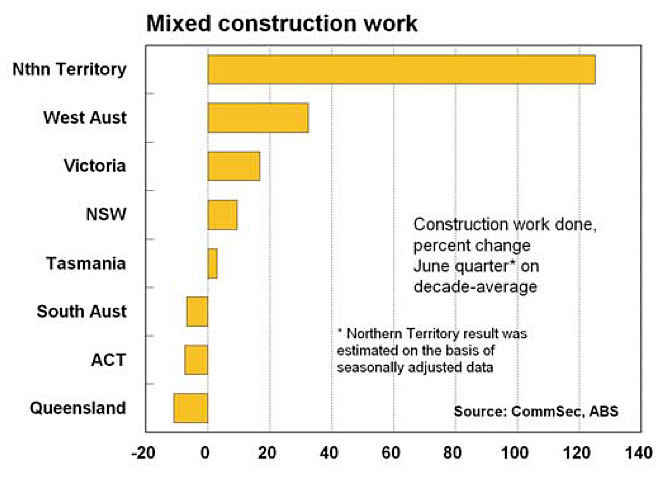How the states are stacking up
How the states are stacking up
Posted on Monday, October 26 2015 at 11:57 AM
Commonwealth Bank of Australia’s research department has released its latest State of the States report, which gives a snapshot of what’s going on in the states’ economies across Australia by examining the indicators of economic growth, retail spending, equipment investment, unemployment, construction work done, population growth, housing finance and dwelling commencements.
The report shows there’s been little change in the rankings, with New South Wales retaining the top spot and Victoria in second. Both states have pushed further ahead of all the other states.
NSW has retained its top rankings on population growth, retail trade and dwelling starts, but now also adds housing finance to the list.
Victoria’s main strengths are population growth, housing finance and dwelling starts (second ranked on each indicator.)
The Northern Territory remains the third ranked economy, but has fallen further behind Victoria and now shares the third ranking with Western Australia. Northern Territory is top ranked on economic growth, business investment and construction work done, but the “top end” economy is last ranked on population growth, housing finance and dwelling starts.
Western Australia is second on retail trade, economic growth and construction work, but higher unemployment (eighth ranked) has affected housing activity.
Queensland retains fifth position on the economic performance table but it’s clear that it’s now in a third grouping of economies with the ACT, South Australia and Tasmania. Queensland is middle-ranked on most indicators.
In the area of construction work, five of the states and territories were showing higher than decade averages.
NSW is fourth ranked with construction work 9.4 per cent above decade averages, while Tasmania is fifth ranked at 2.9 per cent above “normal” levels. In Queensland, overall new construction work completed is now 11 per cent below the decade average after being up 0.5 per cent on its decade average in the March quarter.

In the sphere of population growth, just one state now has population growth above long-term averages (NSW).
Victoria continues to record the strongest annual population growth and is still second on the differential with the decade-average rate. Victoria’s population is 1.68 per cent higher than a year ago although this growth rate is 2.9 per cent below than the ‘normal’ or decade average level.
In three of the states and territories – NSW, Victoria and ACT – trend housing finance commitments are above decade averages. And in six of the eight economies, trend commitments in August were above year-ago levels – all except Northern Territory and Western Australia.

NSW has now taken top spot for housing finance, with the number of commitments 16.3 per cent above the long-term average. Next strongest was Victoria, up 11.7 per cent on the decade-average.
The ACT has slipped from first to third spot on housing finance, but still up 10.3 per cent on the decade average, followed by Queensland (down 3.0 per cent).

When it comes to dwelling starts, the report shows a mixed outlook for housing.
While dwelling starts are above decade averages in six of the states and territories, starts are above levels of a year ago in only half of the states and territories.
NSW retains the mantle of the strongest in the nation for new home construction, with starts just over 52 per cent above decade averages. In addition, in the June quarter the number of dwellings started was 11.4 per cent higher than a year earlier.
Victoria holds second spot, with starts 41.2 per cent above decade averages, followed by Tasmania with starts up 29 per cent on decade averages and Queensland, up 24.8 per cent.

Article source: http://feedproxy.google.com/~r/API_Property_News/~3/hH6T5oPFSTo/how-the-states-are-stacking-up